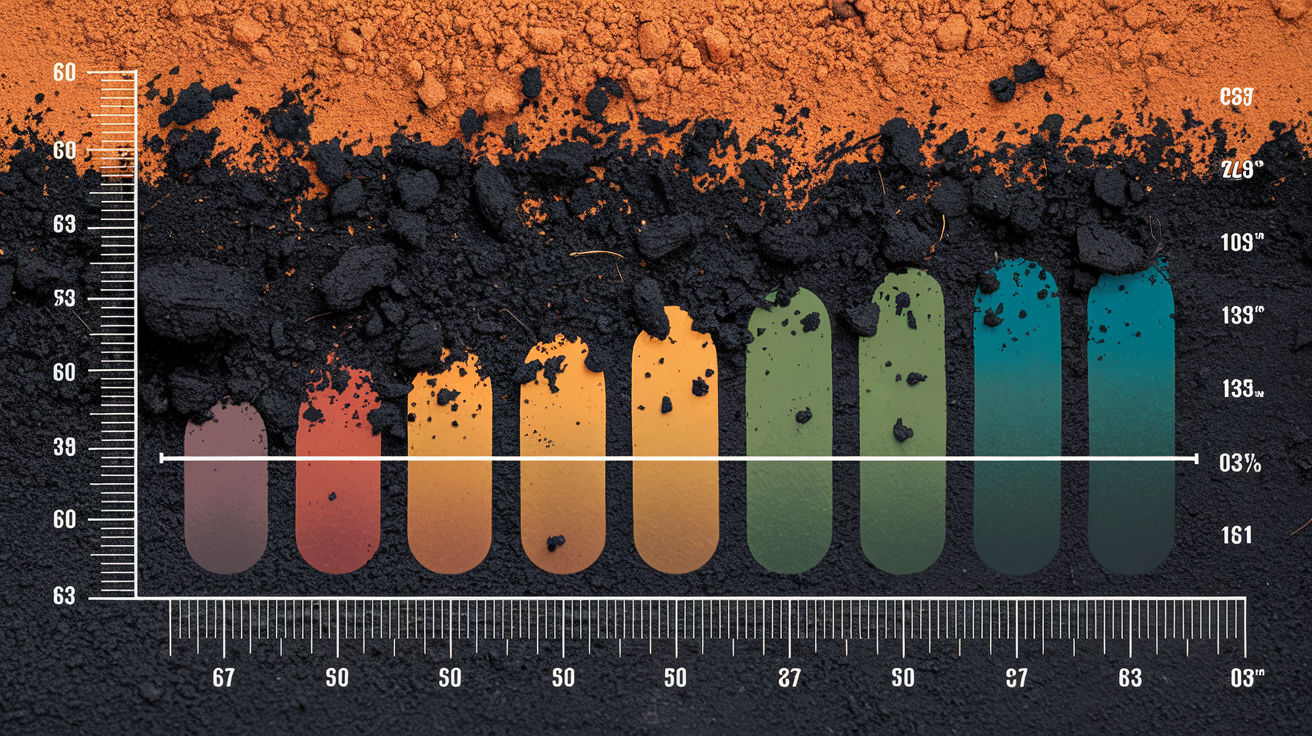Maintaining the right soil moisture is crucial for the health of your plants, and a soil moisture meter can be an invaluable tool in achieving that balance. Rhys Garden and in my years of gardening, I’ve found that using a soil moisture meter alongside a detailed chart can take the guesswork out of watering.
In this guide, I’ll explain how to use a soil moisture meter effectively and how to interpret the readings to ensure your plants get the right amount of water they need to thrive.
Introduction to Soil Moisture Meters and Charts
Soil moisture meters are invaluable devices that take the guesswork out of watering your plants. These nifty tools measure the amount of water present in the soil, providing gardeners with crucial information about when to water and how much. But the real magic happens when you combine these readings with a soil moisture meter chart.
A soil moisture meter chart is a visual guide that helps interpret the readings from your meter, translating numbers or colors into actionable information about your soil’s water content. At Rhys Garden, we believe that mastering the use of these charts can revolutionize your gardening practice, leading to healthier plants and more efficient water use.
The Importance of Proper Soil Moisture
Before we delve into the intricacies of soil moisture meter charts, let’s take a moment to understand why proper soil moisture is so crucial for plant health.
Plants, like Goldilocks, prefer their soil moisture “just right” – not too wet, not too dry. This ideal moisture level:
- Ensures nutrient uptake
- Promotes healthy root growth
- Prevents water stress and wilting
- Discourages fungal growth and root rot
As gardening expert Dr. Linda Chalker-Scott from Washington State University notes, “More plants are killed by improper watering than by any other single cultural practice.” This underscores the importance of accurate soil moisture measurement and interpretation.
Types of Soil Moisture Meters

Before we can effectively use a soil moisture meter chart, it’s important to understand the different types of meters available. Each type has its own method of displaying moisture levels, which will influence how you read and interpret the chart.
Analog Meters
These traditional meters use a needle display, often with a color-coded background. They’re simple to use but may require some practice to read accurately.
Digital Meters
Digital meters provide a numerical readout, often on an LCD screen. They tend to be more precise but may require battery changes.
Combo Meters
These advanced meters often measure not just moisture, but also soil pH and light levels. They can be particularly useful for comprehensive plant care.
Understanding Soil Moisture Meter Charts
Now that we’re familiar with the types of meters, let’s explore how to read and interpret soil moisture meter charts.
Basic Structure of a Soil Moisture Meter Chart
A typical soil moisture meter chart consists of several key components:
- Moisture scale (usually from 1-10 or 0-100%)
- Moisture level categories (e.g., dry, moist, wet)
- Plant types or soil conditions
- Recommended actions (water, wait, etc.)
Interpreting the Numbers
Most soil moisture meter charts use a scale of 1-10 or a percentage from 0-100%. Here’s a general guide to interpreting these numbers:
- 1-3 or 0-30%: Dry soil, watering needed for most plants
- 4-6 or 40-70%: Moist soil, ideal for many plants
- 7-10 or 80-100%: Wet soil, potentially overwatered
However, it’s crucial to remember that these are general guidelines. Different plants have different moisture needs, which is where the true value of a detailed soil moisture meter chart comes into play.
Rhys Garden’s Comprehensive Soil Moisture Meter Chart
At Rhys Garden, we’ve developed a comprehensive soil moisture meter chart based on extensive research and practical experience. This chart takes into account various factors that influence optimal soil moisture levels.
Moisture Levels and Plant Categories
| Moisture Level | Reading | Succulents & Cacti | Herbs & Vegetables | Tropical Plants | Trees & Shrubs |
|---|---|---|---|---|---|
| Dry | 1-3 | Ideal | Water soon | Water immediately | Check deeply |
| Slightly Dry | 3-4 | Water lightly | Ideal for many | Water | Ideal for many |
| Moist | 5-7 | Danger of overwatering | Ideal | Ideal | Ideal |
| Wet | 8-10 | Danger | Danger for most | OK for some | OK for some |
Interpreting the Chart
This chart provides a more nuanced view of soil moisture needs:
- Succulents & Cacti: These drought-tolerant plants prefer drier conditions. A reading of 1-3 is ideal, while anything above 5 could lead to root rot.
- Herbs & Vegetables: Most prefer slightly dry to moist soil. A reading of 3-6 is generally ideal, depending on the specific plant.
- Tropical Plants: These moisture-loving plants thrive in consistently moist soil. Aim for readings between 5-7.
- Trees & Shrubs: Established trees and shrubs can tolerate a range of moisture levels. However, newly planted specimens may need more consistent moisture.
Factors Affecting Soil Moisture Readings
While soil moisture meter charts are incredibly useful, it’s important to consider various factors that can influence readings:
Soil Type
Different soil types hold water differently:
- Sandy soils drain quickly and may read drier
- Clay soils retain water and may read wetter
- Loamy soils, ideal for most plants, provide balanced readings
Temperature and Humidity
Hot, dry conditions can cause soil to dry out faster, while cool, humid conditions slow evaporation. Always consider the weather when interpreting your readings.
Plant Size and Root Depth
Larger plants with deeper roots may require deeper moisture meter placement for accurate readings.
Time of Day
Soil moisture can fluctuate throughout the day. For consistency, try to take readings at the same time each day.
Advanced Use of Soil Moisture Meter Charts
For those looking to take their plant care to the next level, here are some advanced techniques for using soil moisture meter charts:
Creating Custom Charts
While general charts are useful, creating custom charts for your specific plants and growing conditions can be even more beneficial. Here’s how:
- Research optimal moisture levels for each of your plants
- Take regular moisture readings and note plant health
- Adjust your chart based on what works best in your unique environment
Seasonal Adjustments
Remember that optimal soil moisture levels can change with the seasons. In general:
- Spring/Summer: Plants may need more frequent watering
- Fall/Winter: Many plants enter dormancy and require less water
Adjust your interpretation of the soil moisture meter chart accordingly.
Combining with Other Data
For a comprehensive understanding of your plants’ needs, consider combining soil moisture data with other measurements:
- Soil pH
- Light levels
- Temperature
- Humidity
Many advanced soil meters can measure multiple factors, allowing for a more holistic approach to plant care.
Troubleshooting Common Issues
Even with a soil moisture meter and chart, you may encounter some challenges. Here are solutions to common problems:
Inconsistent Readings
If you’re getting wildly different readings in the same area:
- Clean the probe thoroughly
- Check for rocks or air pockets in the soil
- Ensure the probe is inserted to the same depth each time
Readings Don’t Match Plant Symptoms
If your plants show signs of under or overwatering despite “ideal” readings:
- Check your meter’s accuracy with a simple soil squeeze test
- Consider other factors like humidity and temperature
- Consult with a local gardening expert or extension office
Meter Seems Stuck
If your meter always shows the same reading:
- Try in different areas of the garden
- Clean the probe thoroughly
- Check batteries (for digital meters)
- Consider replacing the meter if the issue persists
Frequently Asked Questions
To further assist you in mastering soil moisture meter charts, we’ve compiled answers to some frequently asked questions:
Q: How often should I check soil moisture?
A: For most plants, checking once or twice a week is sufficient. However, during hot, dry periods or for particularly sensitive plants, daily checks may be necessary.
Q: Can I use the same moisture level for all my plants?
A: While it’s convenient, it’s not ideal. Different plants have different water needs. Use our comprehensive chart as a starting point and adjust based on individual plant requirements.
Q: Are soil moisture meter charts accurate for potted plants?
A: Yes, but with some caveats. Potted plants can dry out faster than those in the ground. You may need to adjust your interpretation of the chart for container gardening.
Q: How deep should I insert the moisture meter probe?
A: Generally, insert the probe about halfway between the soil surface and the bottom of the root zone. For most houseplants, this is about 2-3 inches deep.
Q: Can soil moisture meters and charts replace my watering schedule?
A: While they’re excellent tools, they shouldn’t completely replace your watering schedule. Use them to fine-tune your watering practices and to catch any issues early.
Conclusion
A soil moisture meter, when paired with a well-designed chart, is a powerful tool for any gardener aiming to optimize plant care. By regularly monitoring soil moisture levels and adjusting your watering practices accordingly, you can promote healthier, more vibrant plants. Understanding and utilizing this information not only helps prevent overwatering or underwatering but also contributes to the overall success of your garden.

Related Posts
Best Soil for Indoor Plants: A Guide for Thriving Greenery
The Ultimate Guide to Sand Soil Mix for Leveling
Topsoil vs Fill Dirt: Choosing the Right Soil for Your Garden